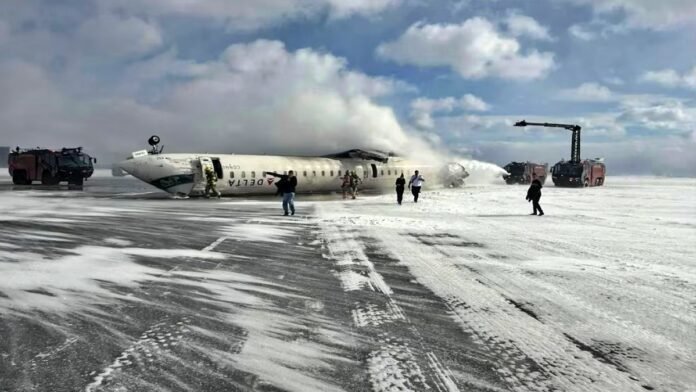
Key Points:
- Delta Airlines Flight 4819 overturned while landing at Toronto Pearson International Airport amid snow and strong winds.
- All 80 passengers and crew survived; 18 people were injured, including three critically.
- Investigations are underway to determine the cause of the crash, with weather conditions being a key factor.
Toronto, Canada: In a shocking aviation incident, Delta Airlines Flight 4819 from Minneapolis-Saint Paul International Airport to Toronto Pearson International Airport overturned upon landing on Monday afternoon. The Bombardier CRJ-900 aircraft, carrying 76 passengers and four crew members, flipped upside down on a snow-covered runway during harsh winter conditions. The crash left 18 people injured, including a child and two adults in critical condition.
The accident occurred at approximately 3:30 PM local time as the plane attempted to land amid strong winds and heavy snowfall. Emergency crews swiftly evacuated all passengers and extinguished a fire that had broken out on the aircraft. Despite the terrifying ordeal, there were no fatalities.
Passenger Accounts: Fear and Resilience
Survivors shared harrowing accounts of the crash. One woman posted a video on social media, showing herself hanging upside down in her seat after the plane flipped. In her caption, she wrote, “My plane has crashed, and I am lying upside down.” The footage captured panicked passengers scrambling to exit the overturned aircraft as smoke billowed from its structure.
John Nelson, another passenger, described the moment of impact in an interview with CNN. “We hit the ground, turned to one side, and then flipped upside down,” he recounted. Nelson also shared a video showing emergency responders spraying water on the snow-covered wreckage.
Injuries and Emergency Response
Among the 18 injured passengers were three individuals in critical condition: a man in his 60s, a woman in her 40s, and a child. The critically injured were transported to local hospitals, including St. Michael’s Hospital and Sunnybrook Health Sciences Center. The child was admitted to SickKids Hospital but was reported to be in stable condition.
Fire Chief Todd Aitken praised the swift response of emergency teams in evacuating all passengers safely. He emphasized that their efforts prevented further injuries or fatalities.
What Went Wrong? Weather Under Scrutiny
The exact cause of the crash remains under investigation by the Transportation Safety Board of Canada (TSB), with assistance from U.S. investigators. Experts believe severe weather conditions played a significant role. Toronto had been experiencing a snowstorm with wind gusts up to 65 km/h (40 mph) and icy runways at the time of landing.
Aviation analysts noted that while Bombardier CRJ-900 aircraft are designed to handle crosswinds up to 35 knots (40 mph), the combination of snow, ice, and wind likely contributed to the instability during landing. Former pilot John Cox pointed out that compressed snow or ice patches on the runway could have caused the plane to veer off course.
Delta Airlines’ Response
Delta Airlines issued a statement acknowledging the incident and expressing relief that there were no fatalities. “Our primary focus is taking care of those impacted,” said Delta CEO Ed Bastian. He commended first responders for their efforts in ensuring passenger safety.
The airline confirmed that Flight 4819 was operated by Endeavor Air using a CRJ-900 aircraft. It assured full cooperation with investigators to determine the cause of the crash.
Following the crash, Toronto Pearson International Airport temporarily halted all departures and arrivals as emergency teams worked on-site. Two runways remained closed for investigation, causing delays across airport operations. Nearby Montréal–Trudeau International Airport accepted diverted flights during this period.
As investigations continue, aviation authorities are focusing on understanding how adverse weather conditions impacted flight operations. This incident serves as a stark reminder of the challenges posed by winter weather in aviation and highlights the importance of rigorous safety protocols.
For now, passengers and crew aboard Flight 4819 can count themselves lucky to have survived one of aviation’s rarest emergencies a plane overturning during landing thanks to quick action by emergency responders and well-trained flight attendants.







































